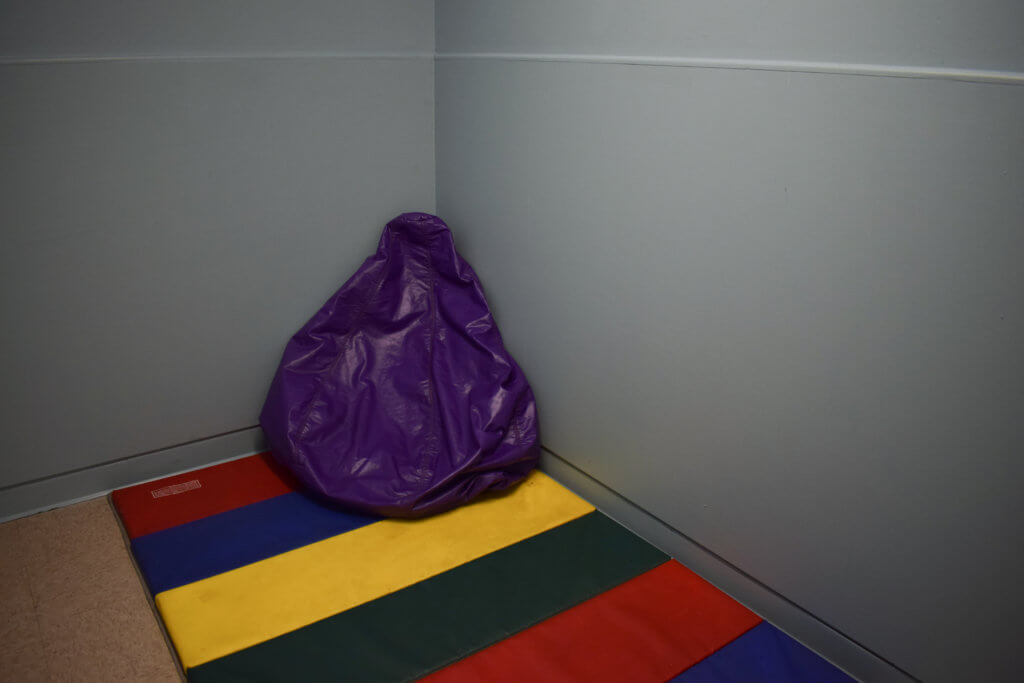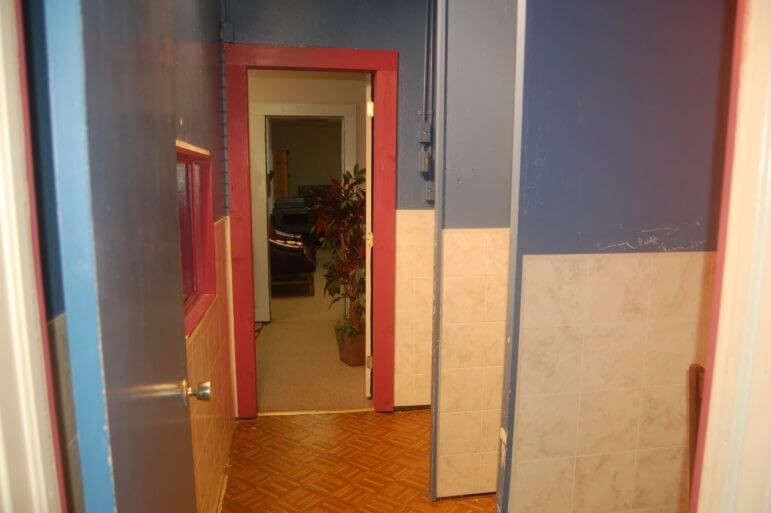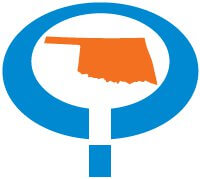(Editor’s note: This post was authored by Jennifer Palmer and appears here in accordance with the non-profit journalism organization’s republishing terms.)
A controversial practice of shutting children alone in small, closet-like rooms to control their behavior has led Oklahoma parents to withdraw their children from school, seek police intervention and take legal action.
School officials give the rooms benign-sounding names like “blue room,” “cool-down room” or “de-escalation room” and say they’re intended to provide a healthy temporary separation. But many parents and child advocates say the practice is like being locked in a closet, and some liken it to solitary confinement in prison. Students placed in such rooms often have special needs.
One father says his special-needs son was placed in a closet for timeout a dozen times in the first two weeks of classes at a Mustang elementary school. In the small Coal County district of Cottonwood, parents say the school placed their son in the narrow “blue room” multiple times for not minding his teacher when he was just 3 years old. Lawsuits have been filed over schools in Cottonwood, Ardmore, Edmond and likely elsewhere.
“We send them into school, and we trust these other adults have been trained to deal with these problems … and they do these outrageous things and we don’t know,” said Jennifer Ashford, a mother who sued the Edmond Public Schools district over its seclusion rooms in 2010.
U.S. GAO report: Students have died
Students have been injured, traumatized and even died in seclusion rooms across the country, according to a 2009 report by the U.S. Government Accountability Office. That report found hundreds of allegations of death and abuse, most of children with disabilities, related to the use of seclusion and restraints in public schools; none of the case studies were from Oklahoma.
Some Oklahoma school officials defend the use of the rooms, saying they are used only in extreme circumstances to isolate a student acting violently. Or, as in Mustang, they are used as part of a program to prevent suspensions of students with severe behavioral and emotional disabilities.
In some schools, the room may be as large as a classroom, with no furniture. In others, it may be a former supply closet with cinder-block walls, a beanbag chair and a lock on the door.

Oklahoma lacks specific laws
Twenty-eight states have laws protecting all students from restraint and seclusion, and 38 states do so for students with disabilities, a 2016 analysis by the Autism National Committee found. Oklahoma doesn’t have a law – it has voluntary, non-binding guidance from the state Department of Education, which advocates say isn’t enough.
The guidance has some parameters on size – large enough so the student can sit or lie down – and the lock – it must automatically disengage in an emergency, such as a fire. The guidance also says the room should have adequate lighting, heating, cooling and ventilation, and a way for staff to see and hear the child at all times.
Schools are supposed to contact parents immediately, and at least within 24 hours, every time their child is secluded. But parents and advocates say many times it doesn’t happen.
“We don’t, as a state, have a good handle on how often these incidents are happening,” said Lori Wathen, of Oklahoma City, whose son has Down Syndrome and who advocates online for a state law with seclusion guidelines. “There’s no law that says schools have to report this. I think it’s happening more than what’s being reported.”
Schools are also supposed to train staff on de-escalation and intervention techniques, possible effects of seclusion and the appropriate use of seclusion rooms — and many districts do. But it’s not required, and that’s a point of contention in one of the lawsuits.
Legislation to restrict the use of seclusion and restraint of special education students, and to codify the guidance on the rooms into law, was filed in 2016 and 2017 by Rep. Josh Cockroft (R-Wanette), but the bills failed to progress. An interim study planned for the fall was not held because of the special session on the budget.
Many states require parents to be quickly notified so they can watch for concussions and hidden injuries. Cockroft’s bill would have given schools 24 hours to contact parents.
The U.S. Department of Education’s Office of Civil Rights surveys schools every two years about academic and discipline issues, including incidents of seclusion and restraint, which are used disproportionately on special education students.
But advocates say the numbers are dramatically underreported. It appears some districts toe the line between seclusion and “timeout”, and an overwhelming majority of districts report zero, which is unlikely to be accurate.
Advocates at the Autism National Committee say if the door is locked or blocked by staff, or students don’t feel they can voluntarily leave the room, it’s seclusion, not a timeout. Temporary, brief timeouts are a recognized behavior-management technique, the committee says.
The state Education Department defines seclusion as “the involuntary confinement of a student alone in a room or area which the student is physically prevented from leaving.” Timeout, it says, is not a form of seclusion.
Research shows seclusion in K-12 schools provides no educational or therapeutic benefit and could be harmful to children, according to a 2014 U.S. Senate committee report. Also, teachers in many districts can, and do, manage violent students without seclusion. Many U.S. schools use a data-driven approach called Positive Behavioral Intervention and Supports to reduce incidents by teaching students alternative behaviors, the Senate report said.
“As educators, we need to find better solutions to restraint and seclusion,” said Josh Fearing, a special-education teacher in the Oklahoma City area.

OKC, Tulsa schools report hundreds of seclusion incidents
For the 2013-14 school year, the latest available, 36 of the more than 500 Oklahoma school districts reported secluding students, the Office of Civil Rights data shows.
Oklahoma City and Tulsa public schools, the state’s two largest districts, reported a combined 437 incidents of seclusion for the 2013-14 school years. The Oklahoma City district says it doesn’t use seclusion rooms.
“We don’t have those rooms in our buildings. Teachers may be using time-outs, or a cool-down area, for those students as a behavior technique,” said Erin Trussell, director of special education for Oklahoma City Public Schools. Students are never alone, and always able to leave and use the restroom, she added.
In some school districts, a seclusion room is also used voluntarily by students who recognize the need to cool off or who may wish to work on schoolwork free from distractions.
Cottonwood Public Schools in Coalgate didn’t report any seclusions in 2013-14, and superintendent John Daniel said the district doesn’t seclude students.
When pressed about what the district calls the “blue room”, a narrow space within the front office containing three student desks, he said students are sometimes sent there involuntarily and the door is closed.
“Sometimes, it’s used for safety,” he said. “Sometimes it’s used for somebody to do homework. Sometimes students with ADHD (attention-deficit/hyperactivity disorder) need some quiet to do work. We’re not trying to seclude anybody.”
Parents sue Cottonwood school

Robert and Ashley Glover used to drive nearly half an hour to have their son attend Cottonwood. The small school, 75 miles northeast of Ardmore, is in a sought-after district for its school report-card score, which was an A+ in 2016.
But then their son’s attitude toward school changed, and he became tearful and scared each morning. They suspected something was wrong. They requested a meeting with the school, and found out he had been sent to the “blue room” several times.
At the time, the boy was in the school’s pre-K program for 3-year-olds.
In the blue room, “he was expected to understand what he did wrong and tell them, ‘I will act right for the rest of the day’ before he got to come out,” Ashley Glover said.
The Glovers, who have filed a lawsuit against the school, also allege a teacher once physically restrained their son for refusing to put on his shoes. The teacher made him sit with his legs crossed and pressed his face to the floor, the parents say.
School officials have not responded to those allegations in court. A lawyer for the school has asked a judge to throw out the lawsuit on a technicality.
Father’s Facebook post sparks backlash
In Mustang, a father’s Facebook post about an elementary school program for special-needs children that repeatedly placed his 6-year-old son into a small room sparked a public backlash on social media. Billy Wynne described the room as a supply closet modified with a half door instead of a full door.
Like Cottonwood, the room was called the “blue room,” and the district says it’s for refocusing and de-escalation. Several schools in the Mustang district have one. Students can enter voluntarily, but can also be forced into one if the student’s behavior is “posing an immediate threat to themselves or others,” district spokeswoman Shannon Rigsby said.
The rooms are used in conjunction with the BRAIN program, an intensive behavior-modification program for children with severe behavioral issues.
“These kids had been suspended, expelled, hospitalized. They had never completed a full year of school — ever,” said Mustang Middle School Principal Kathy Knowles, who helped pioneer the program.

But Mustang doesn’t count incidents when students are placed in a “blue room” as seclusion. Mustang didn’t report any restraints or seclusions of students in 2013-14, and although it did document 15 incidents in 2016-17, Rigsby said, those incidents “may have nothing to do with the blue rooms, which are specific to the BRAIN program.”
In response to the backlash, the district made some changes, including requiring teachers to fill out a form every time a student voluntarily enters one of the rooms and having the BRAIN teachers communicate with parents daily, Rigsby said.
Edmond Public Schools faces outcry
Another district that has faced criticism from parents over its use of seclusion rooms is Edmond Public Schools. Jennifer Ashford alleged in a 2010 lawsuit that her son was forced into a “timeout room” multiple times — once for at least two hours, during which he urinated on himself.
“She (the teacher) would take away his shoes because he would be kicking the door, trying to get out,” Ashford said.
After over a year of litigation, a federal judge sent the lawsuit to district court and Ashford opted not to pursue it further because of the time and energy involved.
Federal education officials visited the district after the lawsuit was dismissed and didn’t recommend any changes, said Nancy Goosen, Edmond Public Schools director of special services.
She said school staff use seclusion minimally and only to protect themselves and others from injuries. There were 33 reported incidents in the 2016-17 school year. According to district policy, the timeout rooms are a last resort if other methods of de-escalation fail.






















